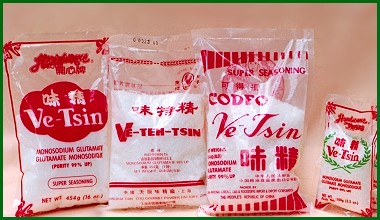We've all hear of it. Nowadays, we all hear about foods not containing it, and how that's supposed to be attractive to us for some reason. Yet most of us (a) have no idea why and (b) what MSG even is. It's everywhere -- in your food, when you go out to dinner, when you buy your favorite crackers, even in the shampoo you use! Some joke it's the Addiction Ingredient manufacturers sprinkle on potato chips or your favorite cookie that's the reason why "you can't eat just one." And in part, that is true.
MSG or Monosodium Glutamate is a a sodium salt of the glutamic amino acids. Translation: it's salty and natural. For example, this amino acid is naturally found in seaweed and Japanese cuisine has been using it for a thousand years to season their food. In the early 1900s, a Japanese scientist successfully separated it out and produced it into a crystalized form, just like ordinary table or kosher salt (not sea salt...that's natural from the actual sea). MSG was then pattened, packaged, and sold as an ingredient to cook with just like we would with salt. Here's what it looks like in packaged form:

And a close up of the crystals:

- it will actually say MSG or monosodium glutamate in the list of ingredients
- also known as Ajinomoto, Vetsin, and Accent
It is often found:
- in most fast food restaurants
- in seasoning spice blends (not individual spices like ground cinnamon or dried thyme)
- pre-prepared stocks and bouillon cubes
- condiments like bbq sauce, salad dressing, steak sauce, worchester sauce, ketchup, mayo
- soy sauces, tamarind (naturally present)
- powdered seasoned items (boxed rice mixes, flavor packets like taco seasoning mix)
- dairy products (milk solids and proteins)
- convenience foods (chips, crackers, candies, quick meals)
- deli meats, sausages
And is found naturally in:
- tomatoes
- mushrooms
- corn
- soybeans
- peas
- wheat & barley
- beer (by way of wheat, barley, yeast)
- yeast
- meat
- fish
- milk
- cheese (by way of milk)
MSG can also be found in shampoos, deodorants, creams, medications (both topical and ingested) and other products.
It's often sprayed on growing fruits and vegetables.
MSG is banned by law to be included in organic foods, but sometimes technically it is still present (as in the milk solids described above). Sometimes during the breakdown of yeast, MSG will form. Therefore, if a product labeled as organic includes yeast or a yeast extract, it will probably also include some amount of MSG. That's why it is also found in breads, desserts and beer.
For the most part it seems MSG as a natural element is harmless to humans. Afterall, the human race has been consuming proteins, fish, milk, cheeses, and wheat and barley (and frankly, drinking beer) for thousands of years with no major implications. I think what concerns some people is the unnatural manufacturing of it by using bacteria and the side effects that might be coming from those in elevated amounts. Let's be honest -- our ancestors weren't consuming steaks with A1 sauce, beef tacos with powdered seasoning packets, or potato chips on a regular basis. And what is of concern is how easily these MSG-laden foods are given to our children. A typical lunch for me growing up was a sandwich (deli meat, bread, mayo/mustard all have msg), a helping of chips (msg), some sort of cookie or candy for dessert (msg) and fruit drink. And that was pretty standard back then and even now. And in our culture where we are so quick to do the fast food thing or order take-out...the levels of MSG add up in one week considerably.
Here is a great link for more information if you think you do have an MSG allergy or wish to read up on food to avoid.

No comments:
Post a Comment